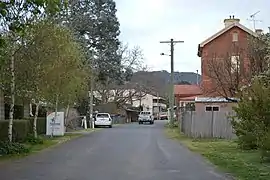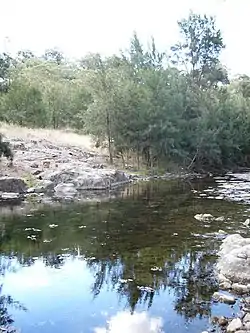Sofala, New South Wales
Sofala is a village in New South Wales, Australia, 255 kilometres (158 mi) north-west of Sydney, within Bathurst Regional Council. It is located beside the Turon River. Sofala is just off the Bathurst-Ilford Road, with only local traffic through the town itself. At the 2006 census, Sofala had a population of 208.[1]
| Sofala New South Wales | |
|---|---|
 Denison Street, the unusually narrow main street of Sofala | |
 Sofala | |
| Coordinates | 33°04′50″S 149°41′35″E |
| Population | 208 (2006 census)[1] |
| Location | |
| LGA(s) | Bathurst Regional Council |
| State electorate(s) | Bathurst |
| Federal division(s) | Calare |
History

Sofala came about as a direct result of the gold rush which had been triggered when Edward Hargraves discovered gold at Summerhill Creek on 12 February 1851. By June of that year, thousands of people had set up mining operations in the valley, and both the Royal Hotel and a general store were built in 1851 to handle the increased demand. Initially, gold was found in the area known as Gold Point on the Turon River. When the alluvial gold ran out, activity switched to quartz reef mining.[2][3] The town was a centre of opposition to the gold licensing system in New South Wales at the time. A considerable number of the miners were Chinese.[4]
Sofala Public School was established in 1878.[5] There was an Anglican church and a Catholic convent.[6] The Convent opened in 1872 and closed in 1909, although it was a church until 1970.[2]
The Gas Hotel was one of the first two hotels licensed, in 1851. The Royal Hotel was established in 1862. There were two other hotels in 1866, the Sofala Inn and the Barley Mow. The Barley Mow had a Cobb & Co booking office.[2]
Now a private residence, the Post and Telegraph Office, built in 1879, operated until 1989.[2]
Attractions today include the gold-rush-era Sofala Royal Hotel[7] and the old gaol. Sofala is reportedly the oldest surviving gold-rush town in Australia. Small-scale gold workings are still active in the area, with prospectors using metal detectors, gold pans, and sluice boxes to recover small quantities of gold.
Popular culture
Russell Drysdale's painting Sofala, a depiction of the main street of the town, won the Wynne Prize for 1947.[8]
The 1974 Peter Weir film The Cars That Ate Paris was filmed in the town. Village scenes in the 1994 John Duigan film Sirens were also filmed in Sofala.
A noted business is Finglinna Studios, which supplies stained glass to churches and other public buildings.[9]
Access
- From Bathurst, Sofala is around 50 km north along the sealed Bathurst-Ilford Road; from Sydney, around 30 km from Ilford.
Heritage listings
Sofala has a number of heritage-listed sites, including:
- Brucedale, 1361 Sofala Road: Grave of Windradyne[10]
- 216 Main Road, west of Sofala: Bridge over Turon River at Wallaby Rocks[11]
- The Gold Commissioner's Residence, 11 Denison Street Sofala: [12]
Attractions
- Prospecting
- Authentic Gold Rush era establishments
e.g The Sofala Royal Hotel (est.1862)
References
- Australian Bureau of Statistics (25 October 2007). "Sofala (State Suburb)". 2006 Census QuickStats. Retrieved 19 November 2009.
- "The Village of Sofala". Mudgee District Local History. mudgeehistory.com.au. Archived from the original on 22 August 2011. Retrieved 24 April 2023.
- "Sofala". Sydney Morning Herald. 10 December 2008. Retrieved 24 April 2023.
- Hickson, Barbara. "Chinese in Sofala". mudgeehistory.com.au. Archived from the original on 17 August 2013. Retrieved 24 April 2023.
- Sofala Public School.
- Mudgee District History: Churches in Sofala
- Sofala Royal Hotel
- "Sofala". Collection. Art Gallery of New South Wales. Retrieved 18 July 2015.
- Finglinna Studios
- "Grave of Windradyne". New South Wales State Heritage Register. Department of Planning & Environment. H01714. Retrieved 18 May 2018.
 Text is licensed by State of New South Wales (Department of Planning and Environment) under CC-BY 4.0 licence.
Text is licensed by State of New South Wales (Department of Planning and Environment) under CC-BY 4.0 licence. - "Bridge over Turon River at Wallaby Rocks". New South Wales State Heritage Register. Department of Planning & Environment. H01458. Retrieved 18 May 2018.
 Text is licensed by State of New South Wales (Department of Planning and Environment) under CC-BY 4.0 licence.
Text is licensed by State of New South Wales (Department of Planning and Environment) under CC-BY 4.0 licence. - https://www.nationaltrust.org.au/blog/historic-places-join-the-national-trust-register/#:~:text=Gold%20Commissioner's%20House%2C%20Sofala,w%20as%20discovered%20in%201851.
- Old Sofala Gaol
- Turon Technology Museum
- Tanwarra Lodge
Further reading
- Higgins, Matthew Gold & Water: A History of Sofala and the Turon Goldfield (1990), ISBN 9781875385003
External links
![]() Media related to Sofala, New South Wales at Wikimedia Commons
Media related to Sofala, New South Wales at Wikimedia Commons